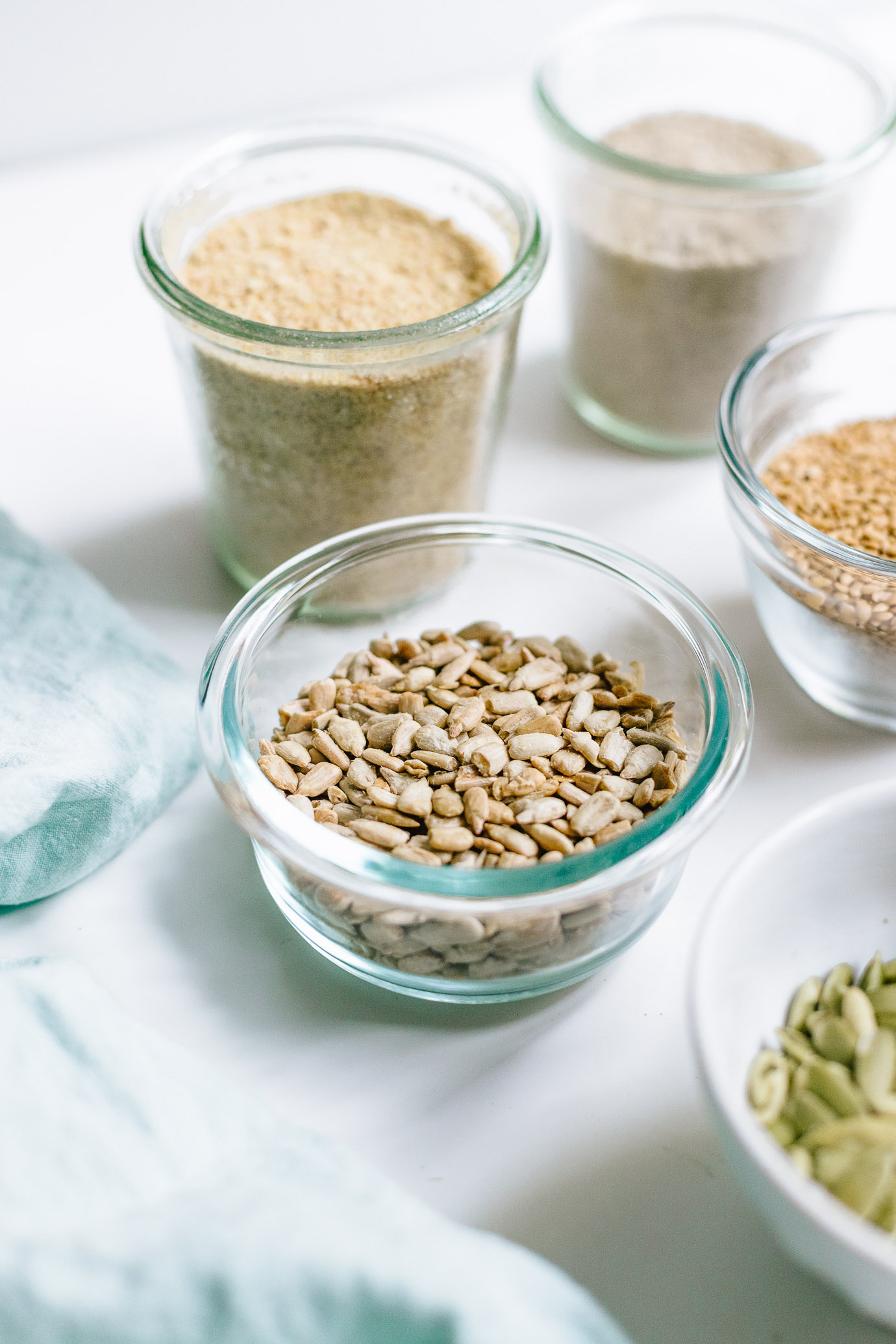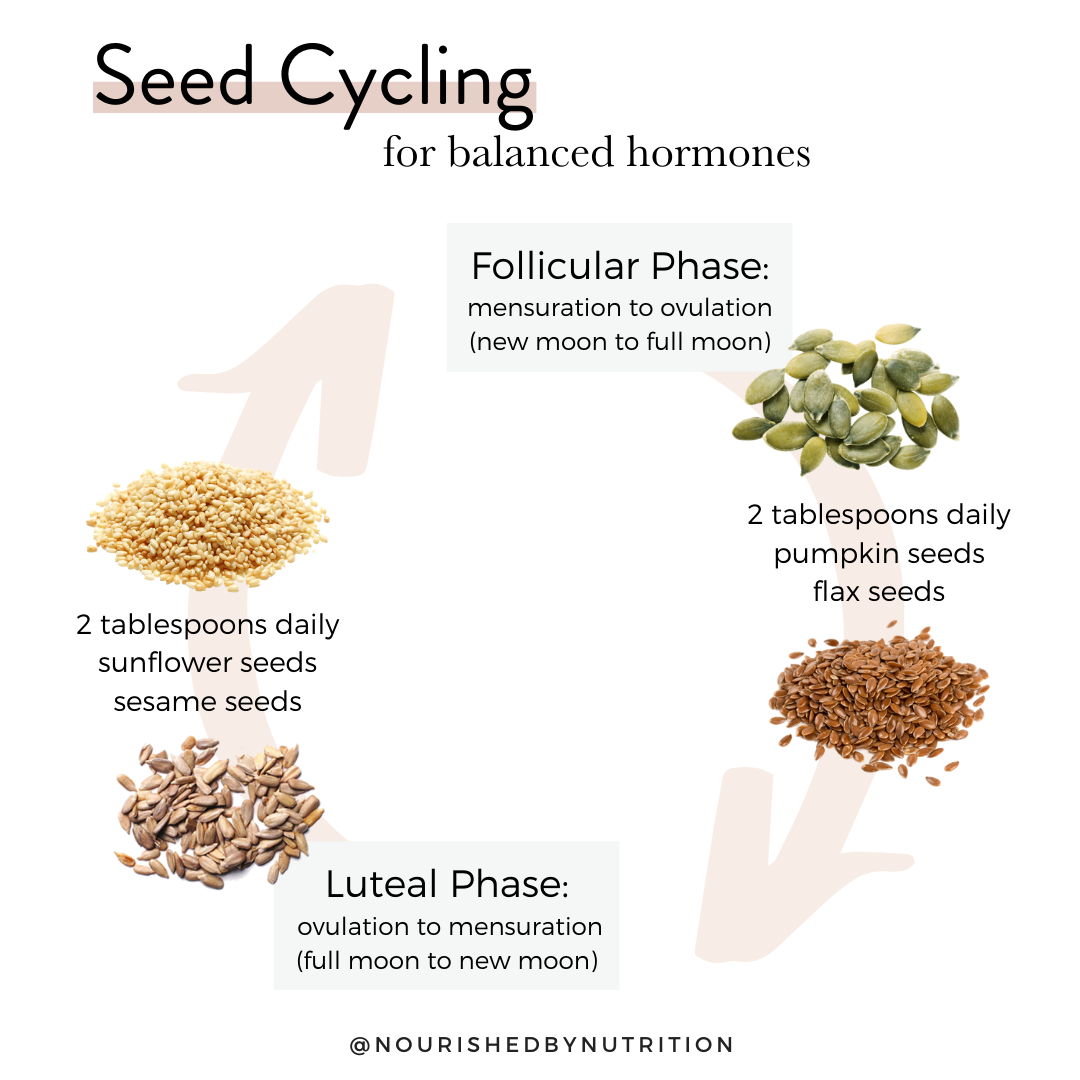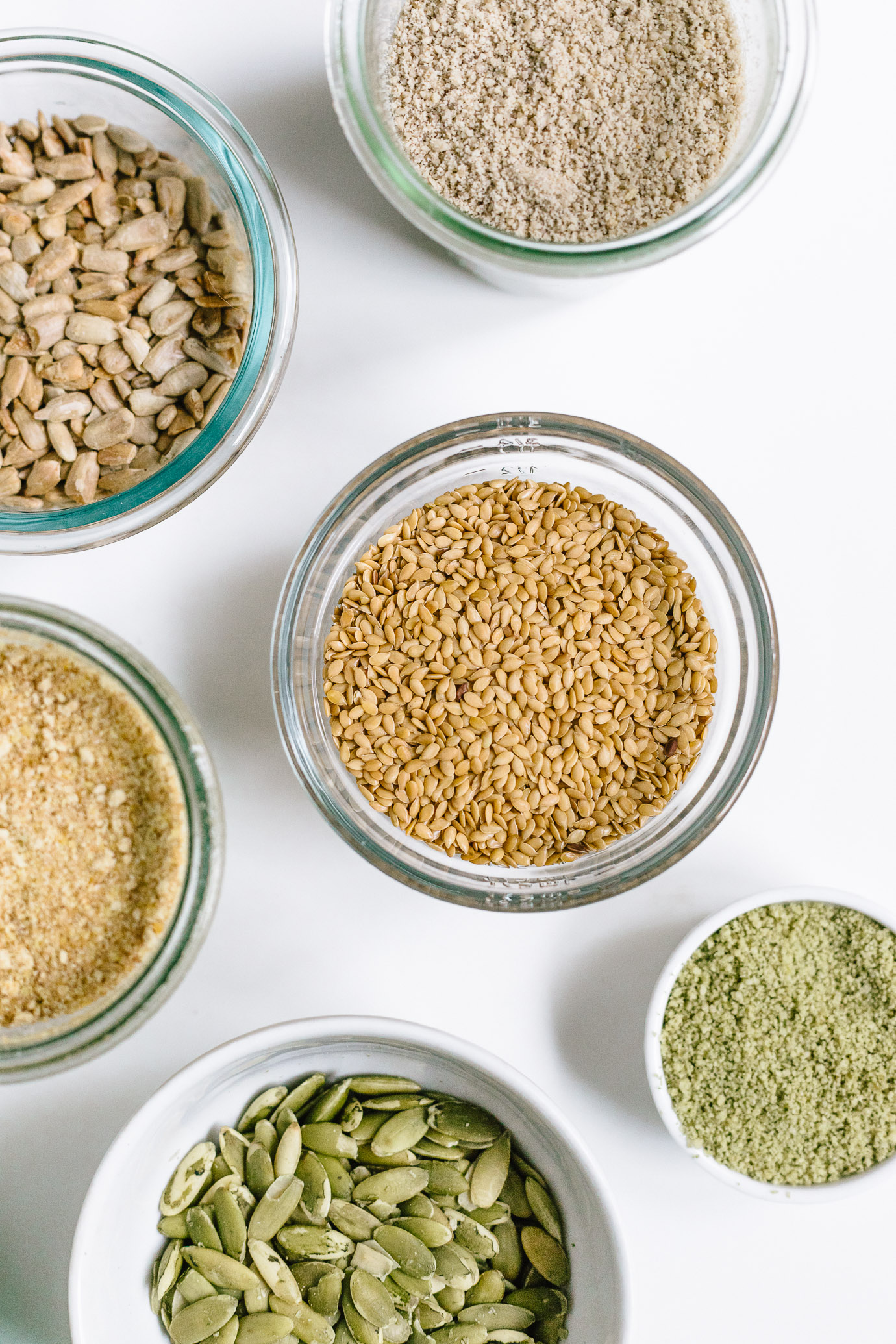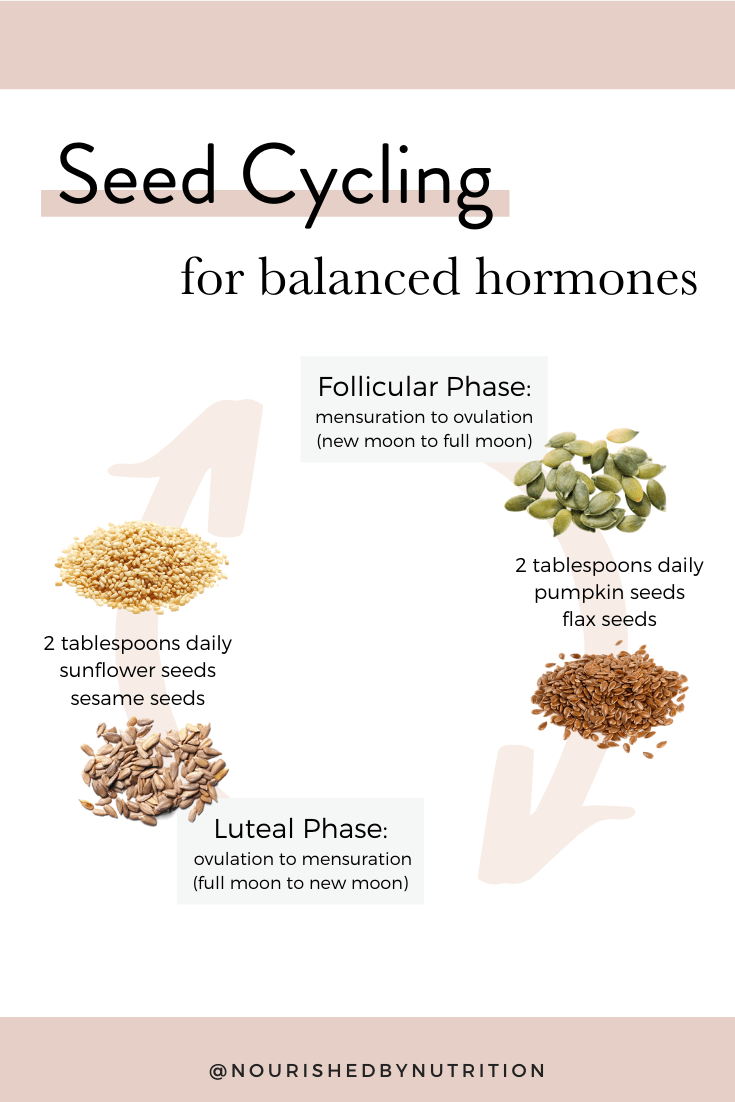Seed Cycling for Hormonal Balance by Jess Bippen
Seed Cycling for Hormone Balance*
*I could not rewrite this blog any better than Jess Bippen from Nourished by Nutrition has, so I am giving full credit to her and her amazing description of seed cycling…I hope you enjoy! You can find her blog here
A science-based guide to seed cycling for hormone balance and to support fertility! Learn what seeds to use, how it supports your hormones and how to incorporate it into your daily routine.
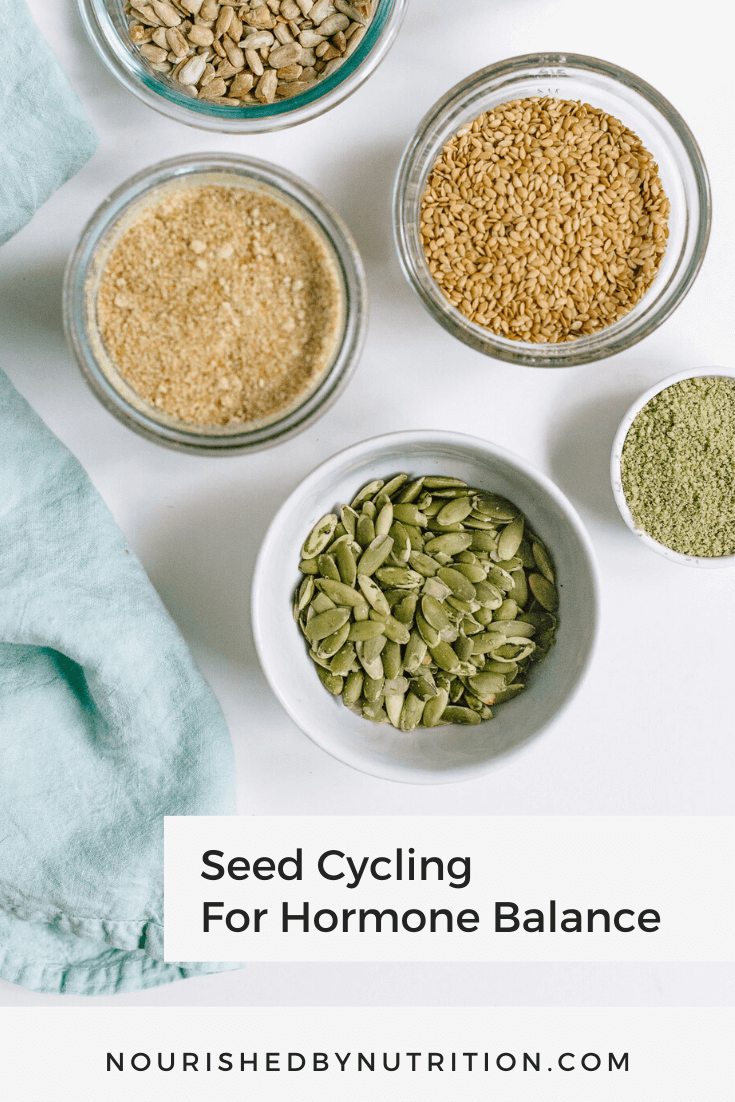
Have you heard of seed cycling? This hormone supporting practice is one of the top trending wellness practices, and for good reason. More and more women are struggling with hormone imbalances.
Women’s hormones are a complex system that functions in a delicate balance. However, these hormones are greatly influenced by your diet, exercise, sleep, stress levels, and environmental toxins. This means that any of these factors can throw your hormones out of that delicate balance. In turn, a slight hormone imbalance can become the underlying issue for a number of health concerns, including irregular periods, acne, PCOS, thyroid disorders, and chronic fatigue.
Seed cycling is one of the easiest ways you can support your hormones in a gentle, yet effective way. This simple practice helps support balanced hormone levels, reduces PMS symptoms, boosts fertility and can help stimulate menstruation if it’s absent (amenorrhea). While seed cycling alone isn’t a cure-all, when incorporated consistently (especially with other hormone stabling practices) it’s a great way to take advantage of the healing powers in food. Read on to learn all about seed cycling and how to incorporate it into your daily routine.
WHAT IS SEED CYCLING?
Seed cycling is the practice of eating specific seeds during the two main phases of your menstrual cycle (follicular and luteal) to help promote the healthy balance of estrogen and progesterone levels. It’s a gentle and completely natural way to reduce PMS symptoms, boost fertility, and can help stimulate menstruation if it’s absent (amenorrhea), and other symptoms as a result of hormonal imbalances.
Seed cycling can be used at any stage of a woman’s life (including post-menopause). However, it’s especially beneficial when coming off of hormonal birth control or struggling with post-birth control syndrome symptoms like acne, irregular periods or missing periods, or PMS.
UNDERSTANDING YOUR MENSTRUAL CYCLE
To better understand seed cycling, you need to understand the two main phases of your menstrual cycle.
The first phase, the follicular phase, begins the first day of your menstrual bleed until ovulation. This typically lasts around 14 days. The second phase, the luteal phase, starts at ovulation until your next menstrual bleed. Luteal phase length can vary but this is also typically around 14 days.
When your hormone levels are balanced, estrogen rises during the first half of your cycle. During the second half of your cycle progesterone levels rise while estrogen levels slowly decline. An imbalance between estrogen and progesterone can contribute to PMS symptoms, menstrual cramps, acne, short luteal phases, anovulation, irregular cycles, and amenorrhea.
Seed cycling is quite simple. You incorporate 1-2 tbsps of pumpkin and flax seeds daily during the follicular of your cycle. Once you ovulate, you incorporate sunflower and sesame seeds daily during your luteal phase.
DAYS 1-14 OF YOUR CYCLE (OR MENSTRUATION TO OVULATION)
-
- 1-2 tablespoons ground flax seeds
- 1-2 tablespoons ground pumpkin seeds
DAYS 15-28 OF YOUR CYCLE (OR OVULATION TO MENSTRUATION)
-
- 1-2 tablespoons ground sunflower seeds
- 1-2 tablespoons ground sesame seeds
If you don’t have a 28-day menstrual cycle, don’t worry! Many women don’t. It’s best to follow the 14 day cycle for each phase of seeds. By staying on track with the 2-week rotation, the process will nudge your body into an optimal menstrual cycle rhythm and help you get back on track.
WHAT IF YOU HAVE AN IRREGULAR OR MISSING PERIOD (AMENORRHEA)?
It’s possible to incorporate seed cycling even if you have irregular or missing periods. Instead of rotating with the phases of your cycling, you’ll follow the phases of the moon as a general guideline.
MOON PHASES SEED CYCLING GUIDELINES
-
- Days 1-14 (new moon to full moon), eat pumpkin seeds and flax seeds.
- Days 15-28 (full moon to new moon), eat sunflower seeds and sesame seeds.
It may seem odd or even a little woo-woo, but the moon is powerful. It controls the waves in the ocean, can affect our center of gravity, and have an effect on your menstrual cycle. Have you ever noticed that the moon and the average menstrual cycle are both 28 days? This is no coincidence. Many women’s cycles (when balanced) naturally follow the phases of the moon.
How does seed cycling support hormone balance?
In truth, there is little scientific research that supports the direct relationship between seed cycling and improved hormonal balance in women. There just haven’t been studies done on this practice. But that doesn’t mean it doesn’t work! It’s important to keep an open mind with nutrition and natural healing practices since there are limitations in research and lack of studies on specific topics.
While studies don’t directly link seed cycling to hormone balance, they show clear correlations that specific nutritional components in flax, pumpkin, sesame and sunflower seeds may play a role in supporting your natural hormonal cycle.
FOLLICULAR PHASE
During the first phase of the menstrual cycle (follicular phase), pumpkin seeds and flax seeds help improve our estrogen levels while preventing excess estrogen. Flax seeds contain lignans which bind to excess estrogen. Pumpkin seeds are high in zinc which helps support progesterone production as you move towards the progesterone rise in the second phase of your cycle.
LUTEAL PHASE
During the second phase of your cycle (luteal phase), sesame seeds and sunflower seeds help boost progesterone production. Sesame seeds are a rich source of zinc which help boost progesterone production and also contain lignans that help block excess estrogen while progesterone rises. Sunflower seeds are high in vitamin E and selenium. Vitamin E can help boost progesterone production, while selenium helps detox the liver of excess estrogen.
THE NUTRITIONAL COMPONENTS IN SEEDS
LIGNANS
Flax seeds are considered phytoestrogens, which have a weak estrogen-like effect in the body. (1) This naturally supports healthy estrogen production. Flax seeds are unique in that they also contain nutritional components called lignans which can help to bind excess estrogen. (2) Research shows that flax seeds help in lengthening the luteal phase, improving ovulation and reducing common PMS symptoms such as breast pain and cramping. (3)
Sesame seeds also contain lignans which help to block excess estrogen during the second phase of your menstrual cycle when progesterone rises. Research shows that sesame seeds are beneficial for postmenopausal women by improving blood lipids, antioxidants, and sex hormones. (4)
ZINC
Pumpkin and sesame seeds both contain high levels of zinc. This mineral helps to improve the formation of the corpus luteum, a transient endocrine structure that develops in the ovary. The corpus luteum is responsible for producing progesterone and stimulates the uterus to thicken in preparation for potential implantation. (5) (6)
OMEGA-3S, OMEGA-6S + VITAMIN E
Both flax and pumpkin seeds are rich in omega-3 fatty acids. Omega-3s promote blood flow to the uterus, increase progesterone secretion, and help maintain healthy cell membranes. (7) In addition, Vitamin E has been linked to reducing PMS symptoms. (8) Research also shows that Vitamin E, omega-3s and omega-6s found in pumpkin, sesame, sunflower, and flax seeds are essential for hormone production and follicle function.
SELENIUM
Sunflower seeds, high in the trace mineral selenium, supports estrogen detoxification in the liver. (9) (2) This helps reduce excess estrogen during the luteal phase when estrogen declines and progesterone rises.
How To Incorporate seed cycling Into Your Everyday Routine:
It’s recommended to eat 1-2 tablespoons of the specific seeds each day. Raw, ground seeds are best, especially for the flax and sesame. You can simply use a coffee/spice grinder to grind the seeds. I grind about a cup at a time and keep it in a glass jar in the fridge or freezer.
Think of your seeds like hormone balancing sprinkles. You can add them to anything! If you’re looking for ways to incorporate your seeds, here’s some ideas to get you started.
Some creative ways to use your seed cycling seed mix include:
-
- Add to smoothies, yogurt, oatmeal or chia seed pudding
- Sprinkle on toast, nourish bowls, salads or soups
- Pesto with pumpkin and flax seeds
- Homemade seed butter
- Make homemade granola with pumpkin and flax or sesame and sesame seeds
- This recipe for seed cycling bites for each phase of your cycle
But why not make your life easier? This is why I love Beeya Seed Cycling Blends.
Beeya Seed Cycling Blend
Beeya is a done for you seed cycling blend that provides the nutrients to bring back balance to your natural hormonal rhythm. Beeya’s Phase One blend consists of freshly ground pumpkin seeds and flax seeds with the addition of hemp seed and chamomile to support your estrogens levels during the first half of your cycle. Beeya’s Phase Two blend consists of freshly ground sunflower and sesame, hemp seeds, and chamomile to support progesterone in the second half of your cycle.
You can feel confident that you’re getting quality with Beeya. Their blends are 100% organic, non-GMO, gluten-free and third party tested.
I love the convenience of having the fresh ground seeds on hand in my fridge. Consistency is key for seeing results and Beeya makes it easy for me to stay consistent. Plus, they ensure the highest quality and have the added functional ingredients like hemp and chamomile which I was regularly consuming in my diet. When there’s quality and convenience, it’s a no brainer for me.
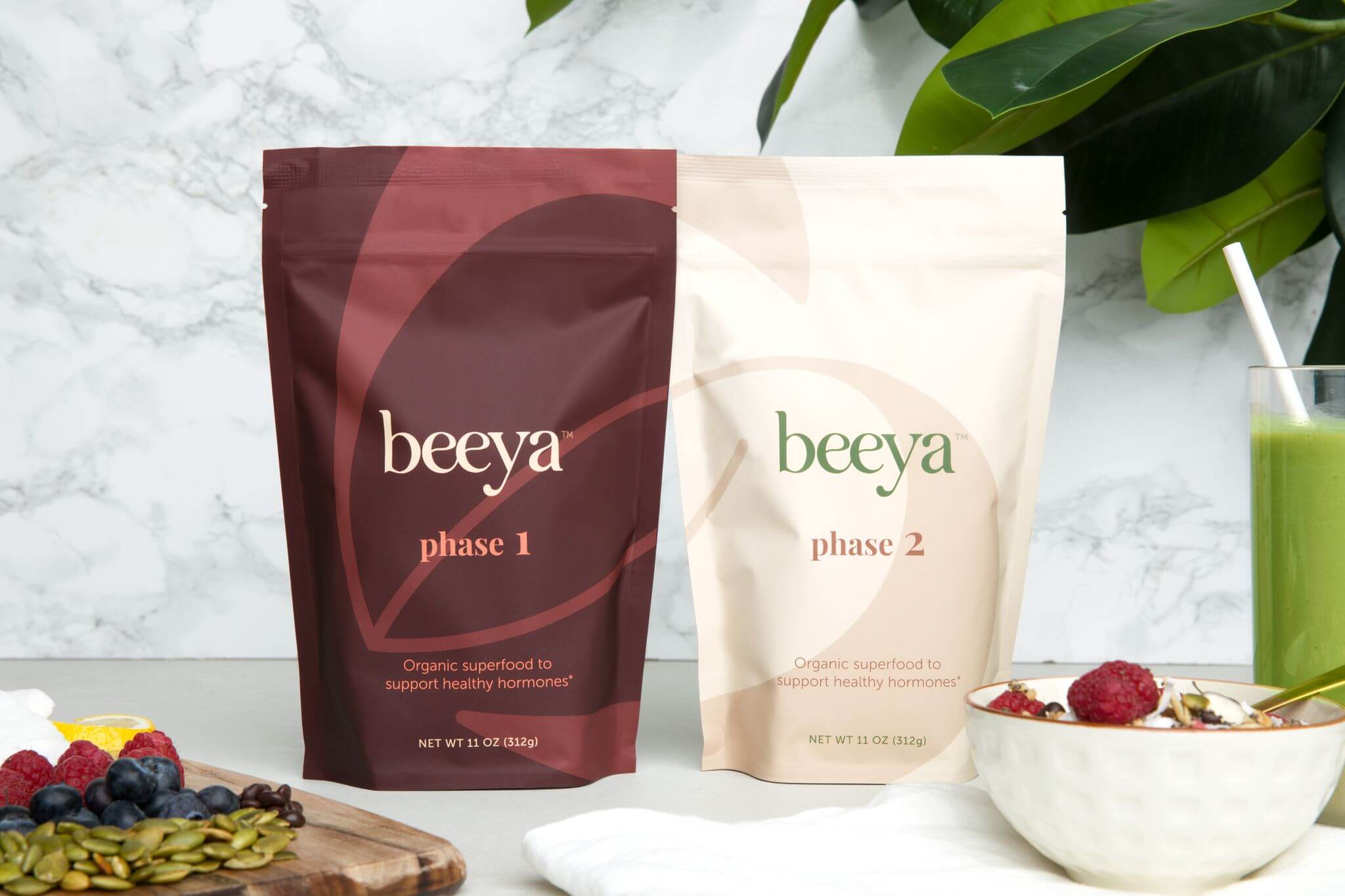
How Long Does It Take To See Results?
Seed cycling takes time to work with your body. It can take at least three months of daily use to start noticing the benefits. Keeping a journal to track your symptoms throughout the month can help you identify the shifts happening over the months.
You might be wondering, do I have to stick with this for life? The truth is, it’s entirely up to you. Seed cycling is such an easy and gentle way to naturally support your hormone balance daily, you may want to consider it. It may feel daunting to think about doing this forever, but once you get into a habit, it may become second nature. I recommend taking it month-by-month. Making a monthly goal to seed cycle makes it feel much more manageable.
THINGS TO KNOW BEFORE YOU START
GRIND YOUR SEEDS
Use a coffee or spice grinder to grind or chop the seeds (especially the flax and sesame). This helps your body digest them. That being said, if you aren’t able to grind them, that’s okay. Incorporating the seeds is better than not because they aren’t ground. The only exception is flax seeds, which your body can’t break down or absorb if left whole.
If you don’t want the extra step of grinding your seeds, I recommend Beeya Seed Cycling Blends, a freshly ground blend of seeds for each phase of your cycle. Having their done-for-you blends takes the extra steps of preparing and grinding your seeds off your plate.
USE RAW SEEDS
It’s best to use raw (unroasted, unsalted) seeds to ensure they have all of their nutrients intact and nothing was lost in the roasting process. Using organic seeds when available helps reduce pesticide exposure which can disrupt hormones.
STORE IN THE REFRIGERATOR OR FREEZER
The polyunsaturated fats in seeds oxidize and go rancid very quickly, especially in sunlight and warmer temperatures. Keeping the seeds in a cool, dark place like the fridge or freezer to keep them fresh.
TRACK YOUR CYCLE
This is so important! While you can follow the moon phases, it’s best to rotate seeds with your unique cycle. In order to do this, you need to track your cycle.
I recommend the basal body temperature method for tracking your cycle. You can use an oral thermometer before you get out of bed in the morning. But I prefer to use the Ava Bracelet. It tracks your basal body temperature and other parameters that can help predict ovulation. I truly believe this is the reason we got pregnant so quickly! It’s 100% worth the investment.
PRIORITIZE HORMONE BALANCE
Keep in mind that seed cycling isn’t a cure-all. Hormone imbalances are often a result of digestive issues, blood sugar imbalances, stress, a lack of dietary fat and protein, lack of sleep, and environmental toxins (like your cleaning and skincare products). You can’t expect seed cycling to give you the boost you need without prioritizing good sleep, managing your stress, eating well and staying hydrated and limiting your exposure to hormone-disrupting toxins.
Need More Guidance?
Hormone balance is complex since there are so many factors that play into this delicate balance. It’s important to work with a doctor to test your hormone levels and properly diagnose your condition. Once you have this information a dietitian can help make diet and lifestyle changes to help you balance and maintain optimal hormone levels.

